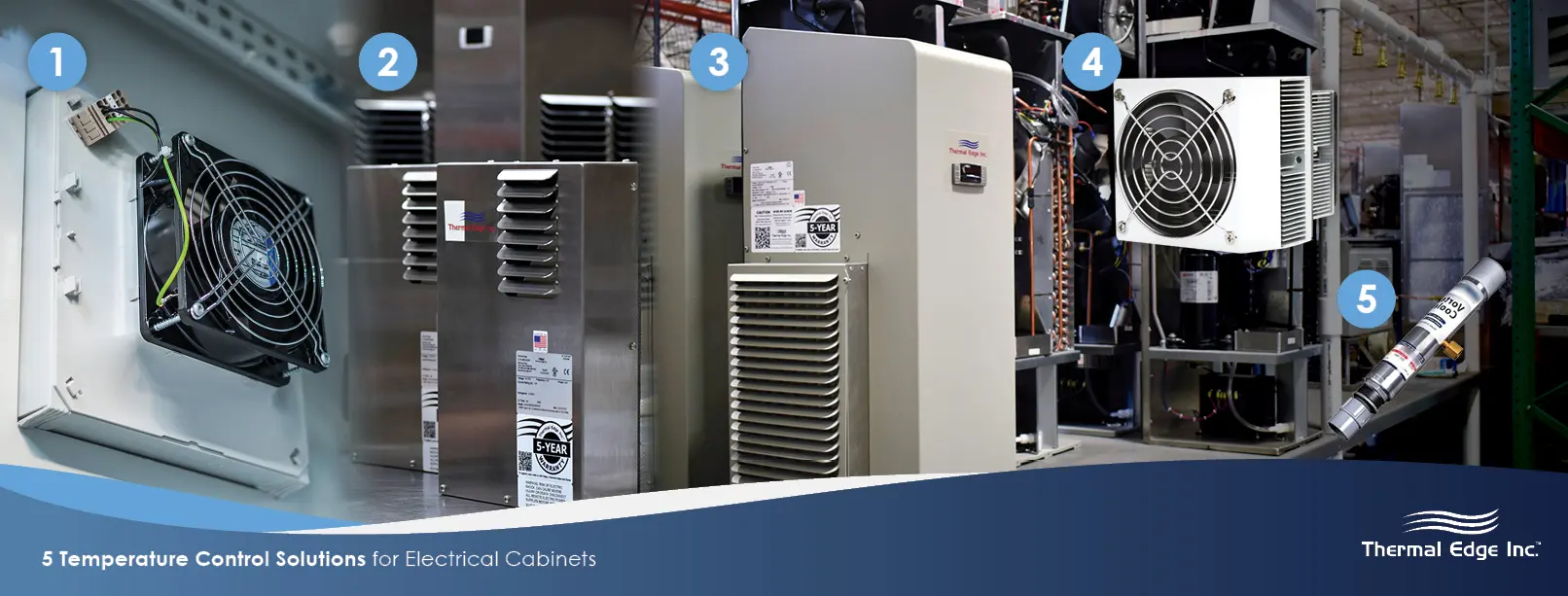5 Temperature Control Solutions for an Electrical Cabinet

The most common reason for reduced efficiency, malfunctioning and failure of electrical equipment is high temperature. Electrical equipment such as variable speed drives and PLCs are designed to work within a particular temperature range. It is reported by Schneider that a 10°C increase in temperature could halve the life of the equipment. Therefore, it is imperative that the enclosure that houses the electrical equipment be designed with thermal management solutions in mind. A small investment in temperature control solutions could result in increased uptime and lower maintenance issues, improved efficiency of equipment and an increase in overall productivity for your business.
Temperature Control Solutions
A typical cooling system can be either passive or active. Passive cooling systems involve design and location changes to leverage the environment or enclosure properties to cool the electrical equipment. Their potential in cooling the enclosure is very limited. Active systems, on the other hand, use technology to cool the enclosure and are more efficient. There are a number of different products in the market that can be used to control the temperature of your electrical cabinet.
1. Filtered fans
Cabinet fans use forced convection and heat transfer properties of air to remove heat from your enclosure. For normal efficient performance of a filtered fan, the environment must be cool and clean, and your equipment must be able to operate at temperatures higher than the ambient temperature.
2. Heat exchangers
Heat exchangers can be either air-to-air or air-to-liquid. The primary advantage of heat exchangers is that the air inside the enclosure has no contact with the environmental air. Heat transfer takes place from the enclosure air to the environment through heat pipe technology. Air-to-air heat exchangers are rated for moderate heat loads, while air-to-water heat exchangers have a much higher cooling capacity. They are designed for operation in conditions where the ambient temperature is lower than the desired enclosure air temperature and the enclosure must be sealed.
3. Air conditioners
Enclosure air conditioners are refrigerant-based devices that operate with a compressor-based system. They are slightly more expensive options but they have an extremely high rate of cooling that makes them suitable for severe applications. They are available in various models for specific applications and include comprehensive temperature control and monitoring systems, and condensate management systems. Standard models are not designed for operation in extreme conditions, so advanced options like corrosion resistance and hazardous location packages make them more rugged. They are preferred to cabinet fans and heat exchangers with their ability to reduce the temperature of the enclosure to below ambient temperature.
4. Thermoelectric coolers
Thermoelectric coolers use the Peltier Effect to remove heat from electrical equipment inside enclosures. Their technology uses no working fluid and no mechanical moving parts; therefore the devices are virtually maintenance-free. However their low cooling capacity limits their operation to small enclosures and small heat loads. They are not very energy efficient and are typically used in indoor and outdoor applications that include thermal management of battery systems, security systems and small industrial equipment.
5. Vortex coolers
Vortex coolers use forced air to cool the enclosure but rather than using a fan for convection, they use compressed air tanks. This overcomes the limitation of an open loop system with fans. A compressor with a set of particulate filters installed on site usually serves as the compressed air source. They are capable of cooling the system below ambient temperature and have a moderate cooling capacity.
To find out which of these temperature control solutions suits your requirement, contact our sales team at Thermal Edge and get a free consultation.

